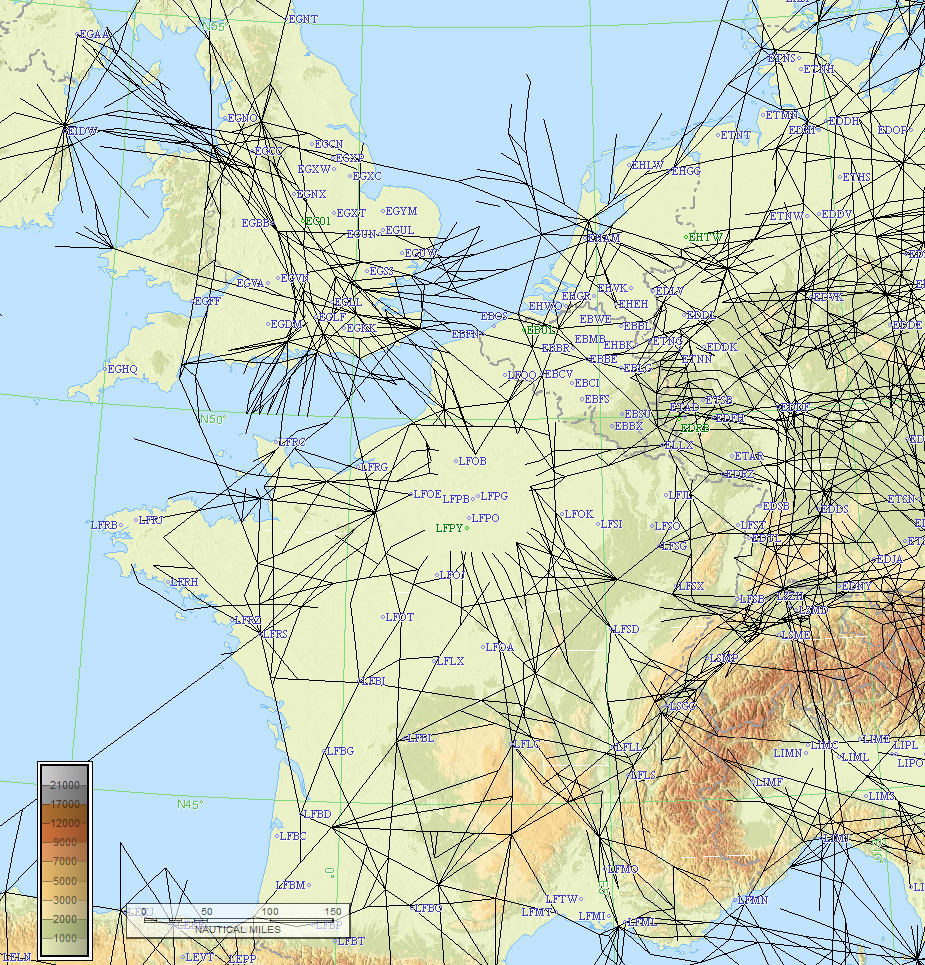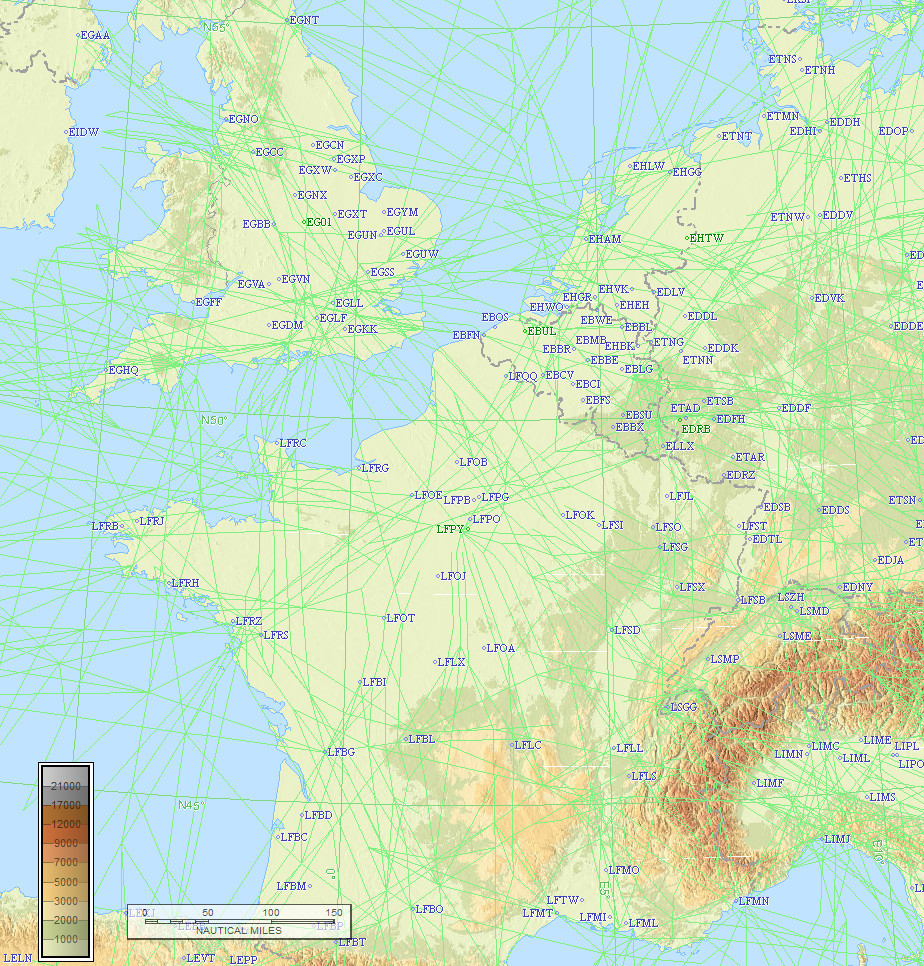I forgot to say that Rocketroute also contacted me very quickly after the original post. They upgraded my account to see if the new performance profile features improved my routing options. Not had time to try yet. But I was told that their service uses no less than 7 routing engines to give customers the best options.
My experience is that Autorouter is better than RocketRoute. I tend to try both and invariably lift the AR route across to RR for FPL filing (RR has handy things like GARs, handling, fuel etc).
A routing tool does not need to get incredibly technical.
My experience with AR since its start is that you almost never fly the route it generates. Often, ATC don’t know what to do with you and in some cases they just plainly ignore it (usually the case in Belgium for example). So a router which generates a route what is a few % shorter than another is not in itself valuable for the actual flight. What happens is that one asks (or should ask) for shortcuts during the flight and that has a tendency to equalise various route generators.
This LSB-EGKA flight is one example of working all possible shortcuts. It failed to work around Paris but that is always the case (below FL200) because the military areas etc there are operated with 100% rigidity – even at weekends when they are mostly shut 
I have never seen any evidence that your ability to extract shortcuts from ATC is affected by the tool used to generate the route. Whether ATC will give you a shortcut depends on their operational situation (which you mostly can’t know), whether your flight falls wholly within their sector (phoning the next sector may be impossible, or just too much bother / workload unless you ask nicely, perhaps in local language) and finally whether there is hazardous wx around (“request xx degrees left to avoid” should never be denied, because nobody will fly into a CB so eventually the ATCO will have to climb down).
I am sure I could fly perfectly well with the now-defunct FlightPlanPro beta v0.0.0 
The biggest thing with a routing tool which generates a roughly good route is whether the user interface is workable in real life scenarios. It does need to work on a phone because sod’s law is that no matter what backups you have, the phone is all you will have with you when you are in some airport office and screwed over by an ATC strike, etc, and have to do a major replan, and your laptop is in the backpack in the plane, or at home (I sometimes do 2-3 day trips without the laptop, and many pilots don’t even have a laptop).
You need routing through fly-by waypoints, to force the route through somewhere. This inconclusive thread illustrates one such requirement; there is no present solution other than to get a view of some sort of IFR enroute chart, somehow overlay a radar/IR image onto it (not sure if any site actually does this and delivers a readable IFR map) and pick off some waypoint names which avoid the worst of it, use them as fly-by waypoints, and then file it and quickly get going.
You need an easy interface for delaying a flight plan, workable from the back of a taxi, and ideally also bringing it earlier (that needs the new one to be validated before cancelling the original, obviously, but it still carries a high risk of a CTOT on such a late filing).
You need an easy interface for editing a validated route. Usually this is to insert the VFR and IFR keywords, to create a VFR segment passing through a region where there is an ATC strike  One is rarely in a position to do significant edits while on the move which will still validate, although you may well want to insert a fly-by WP and re-route, to avoid some widespread convective wx which you know perfectly well you will have to route around.
One is rarely in a position to do significant edits while on the move which will still validate, although you may well want to insert a fly-by WP and re-route, to avoid some widespread convective wx which you know perfectly well you will have to route around.
Rigid aircraft performance models (as Autorouter operates) are more trouble than they are worth. Normally nobody cares, because the model is rarely right anyway (engine thermal management takes precedence over a Vy climb to FL180  ) and nobody cares much whether you land half an hour late (provided the airport is still open and if it isn’t then you messed up elsewhere). In certain cases, e.g. where ATC is totally militant and cancels the FP for a good laugh if the ETA doesn’t hit the purchased arrival slot (as happened at Aero Friedrichshafen) and leaves you stranded because all the slots are sold, you want to be able to directly edit the EET. In such a case I would file the FP with another service (EuroFPL) which allows anything to be edited. Eurocontrol has a lot of leeway on aircraft perf; of the order of +/- 1.5×.
) and nobody cares much whether you land half an hour late (provided the airport is still open and if it isn’t then you messed up elsewhere). In certain cases, e.g. where ATC is totally militant and cancels the FP for a good laugh if the ETA doesn’t hit the purchased arrival slot (as happened at Aero Friedrichshafen) and leaves you stranded because all the slots are sold, you want to be able to directly edit the EET. In such a case I would file the FP with another service (EuroFPL) which allows anything to be edited. Eurocontrol has a lot of leeway on aircraft perf; of the order of +/- 1.5×.
Obviously different pilots will have different views but for pistons I have done quite a lot of this, reaching 189 airborne hrs in one year, ~2400hrs TT, and much of that being Eurocontrol IFR.
And ForeFlight web presentation is now fixed – that was quick!
Peter, I agree with most of what you say; the reality rarely reflects the plan and you need to start somewhere, with the UI whilst planning being vitally important. However, in my line we are often trying to get as far as absolutely possible on one splash of fuel. it is at that point where the difference between an 8% and a 2% margin starts to matter as, unfortunately, I’m not allowed to ‘factor in’ the reasonable assumption that ATC will give me lots of DCTs. Yes, I almost always land with more fuel than originally planned but that’s an unfortunate nature of the game.
Peter wrote:
Rigid aircraft performance models (as Autorouter operates) are more trouble than they are worth. Normally nobody cares, because the model is rarely right anyway (engine thermal management takes precedence over a Vy climb to FL180 ) and nobody cares much whether you land half an hour late (provided the airport is still open and if it isn’t then you messed up elsewhere). In certain cases, e.g. where ATC is totally militant and cancels the FP for a good laugh if the ETA doesn’t hit the purchased arrival slot (as happened at Aero Friedrichshafen)
I don’t get what you mean by rigid. Eurocontrol operates performance models which are often poor so Autorouter provides its own which help get flight plans accepted is my understanding.
You are right that if you never fly your route the ETA and fuel burn are not likely to matter but equally there are a lot of situations like like you mention with slots where you do want the best possible estimate. Equally fuel burn. The accuracy of something like the AR and FF atmospheric and aircraft models is quite remarkable really. I am usually within 4-5% fuel burn and 5 minutes of eta.
I think the trend in controlled airspace is for more direct routings and this will mean the estimates can become more reflective of reality for more pilots.
Peter, although I agree with you that you rarely fly the route filed it does matter in terms of route charges. I pay charges on my Aztec and this is based on the filed route not the one flown so the lowest overhead for filing is always better.
JohnR wrote:
Peter, although I agree with you that you rarely fly the route filed it does matter in terms of route charges. I pay charges on my Aztec and this is based on the filed route not the one flown so the lowest overhead for filing is always better.
That’s a good point John. The only thing I would point out is that what matters is the GC distance between each FIR entry and exit point.
On occasion when trying to get something filed I have had to accept for example some weird intra German routings which generate a large overhead but do not actually affect the route charge.
You are right that if you never fly your route the ETA and fuel burn are not likely to matter but equally there are a lot of situations like like you mention with slots where you do want the best possible estimate. Equally fuel burn. The accuracy of something like the AR and FF atmospheric and aircraft models is quite remarkable really. I am usually within 4-5% fuel burn and 5 minutes of eta.
I think the trend in controlled airspace is for more direct routings and this will mean the estimates can become more reflective of reality for more pilots.
That’s is true for the upper airways (FL200-FL450 or so) where you fly in a jet, Jason. In a piston, winds affect it a lot more and the EET can be 20-30% off. The upper airway routings are also usually pretty straight.
What can be thus useful is wind-optimised routing, although usually it is blindingly obvious how to do that manually when it is really desirable, when you look at windy.com – as shown e.g. here.
I don’t get what you mean by rigid. Eurocontrol operates performance models which are often poor so Autorouter provides its own which help get flight plans accepted is my understanding.
The Autorouter aircraft model fixes your EET from the perf model and you cannot edit the EET (or your TAS, etc) at all. You have to file the FP with whatever it generates.
Lower airways:

Upper airways:

Now I‘m confused. Using the autorouter engine in GP with the performance data of the POH and flying the numbers, I nearly always arrive at the destination in a time slot around 5 minutes plus/minus to the ETA. The differnce is that close to the target, because the shortcuts on the routing are normally flattend by a vectored ILS approach or by the SID and the STAR which are often not the ones used in real flights. SIDs and STARs are calculated by the AR or GP regarding the shortest way. So i.e. at EDDS AR and GP often make use of the STG departure which are fine for Brussels validation, but are only allowed for local IFR trainings flights. So you will recieve a routing change on departure.
Anyway as far as I could remember, the planed routing should be as close to the routing you intend to fly, because in case of communication failure in IMC this routing should be used to get save and coordinared back to the ground. At one point after radio failure ATC will expect, that you do fly on the filed routing and will arrive as close as possible to the estimated time at the IAF.